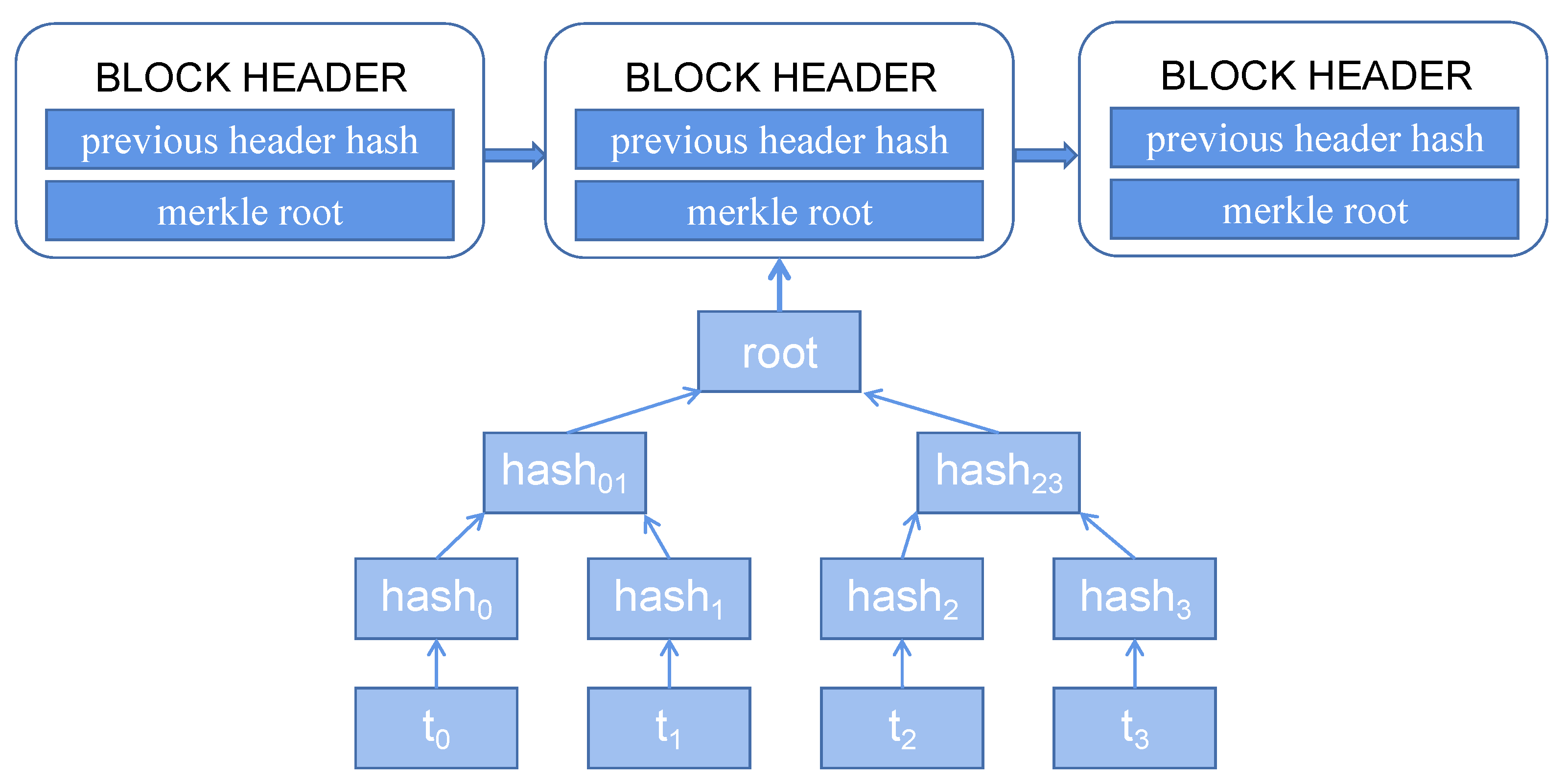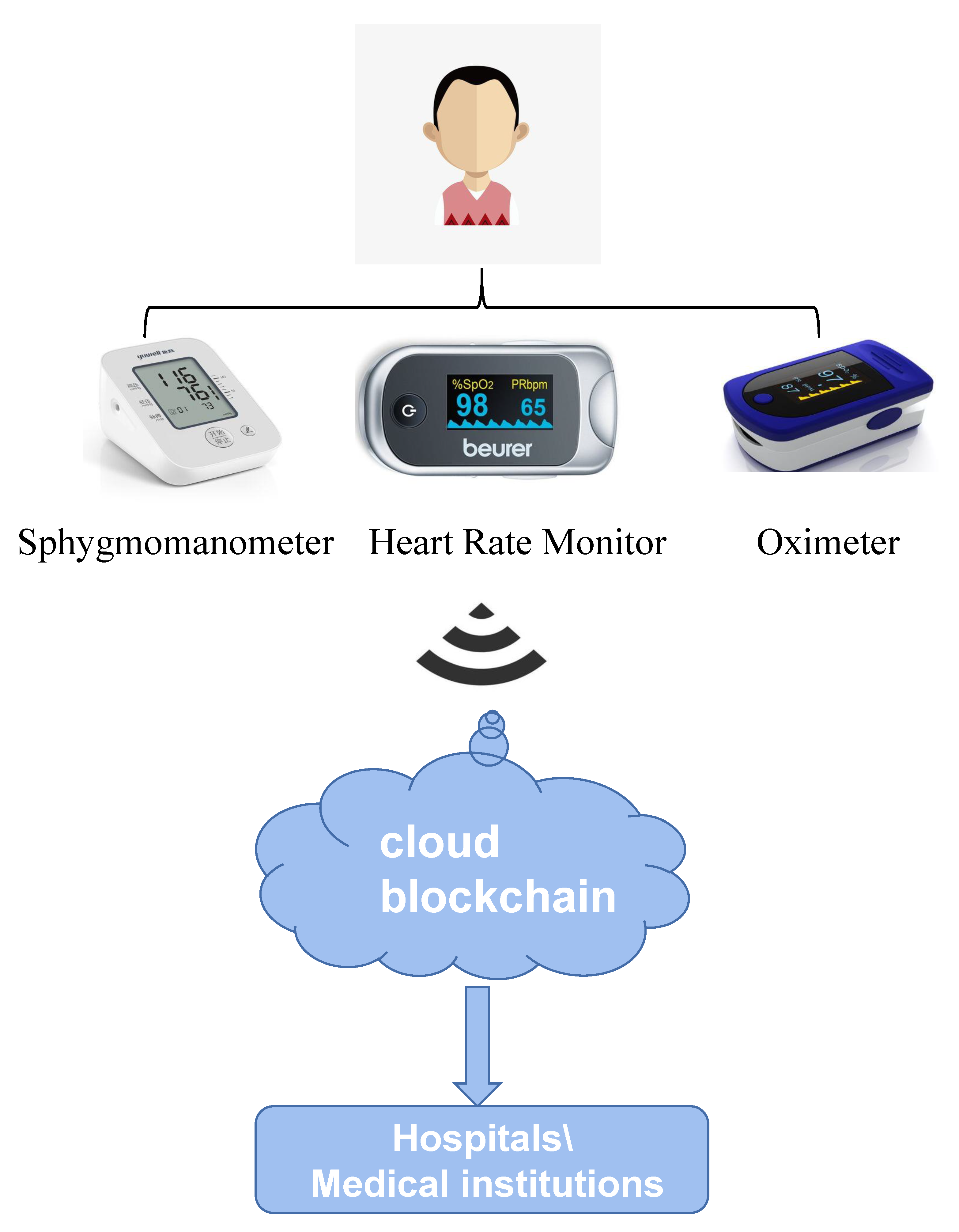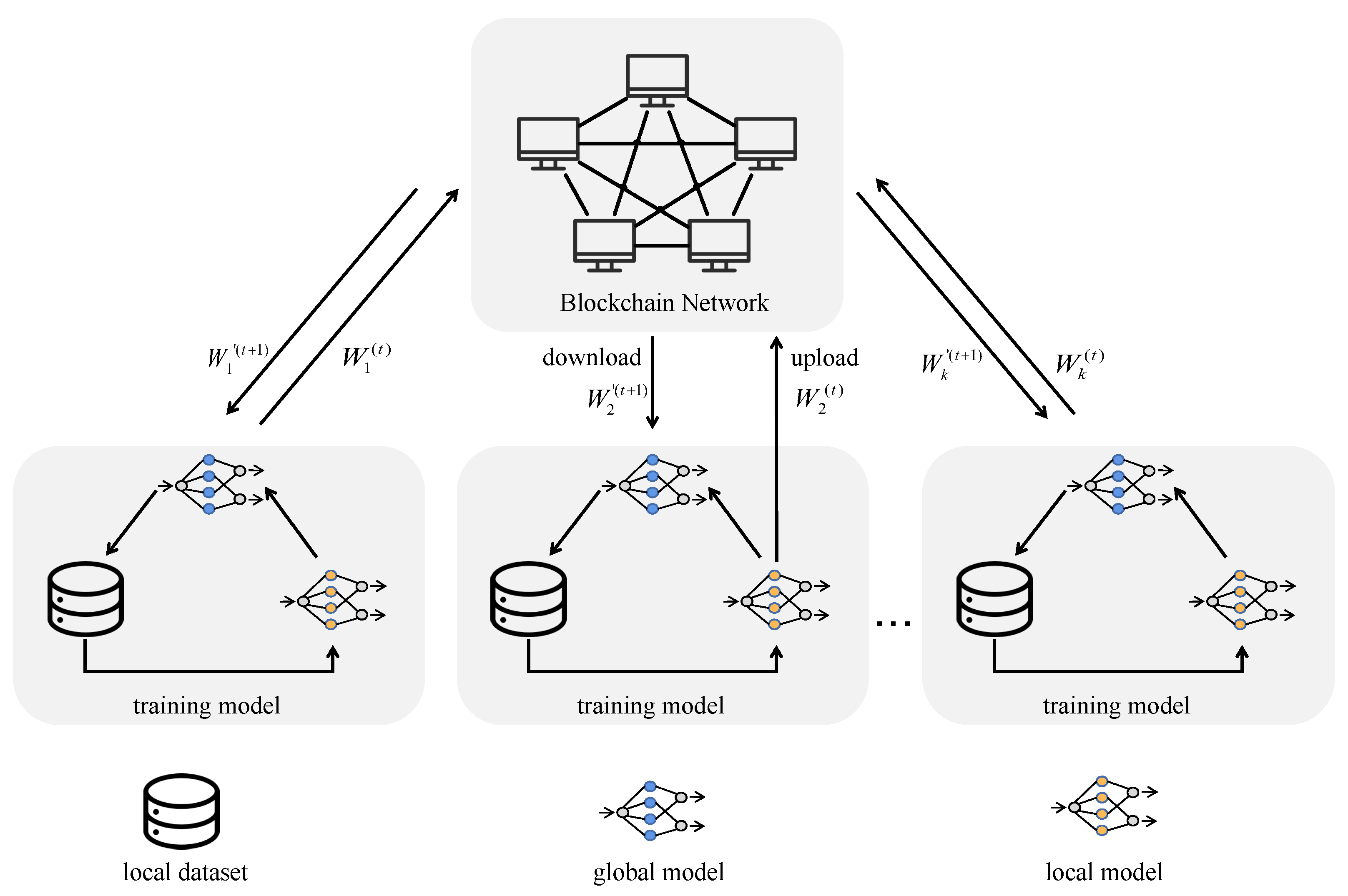A Review of Blockchain-Based Secure Sharing of Healthcare Data
Abstract
:1. Introduction
2. Blockchain
2.1. Background of Blockchain
2.2. Classification of Blockchain
2.3. Consensus Algorithm
2.4. Smart Contracts
- 1.
- Decentralized: The execution of smart contracts does not need to rely on the participation or intervention of third-party organizations, and the supervision and arbitration of contracts are performed by computers;
- 2.
- Untamperable: Once a smart contract is deployed, all contents cannot be modified. This is somewhat like a contract in the traditional world, which cannot be modified once it is signed;
- 3.
- Low cost: Since smart contracts do not require supervision by a third-party intermediary, once a breach of contract occurs, the code is enforced and has a much lower cost compared to traditional contracts;
- 4.
- Open and transparent: Once deployed successfully, a smart contract will run according to the design code and can be viewed by anyone, with a high degree of transparency [21].
3. Blockchain in Healthcare Data
3.1. Blockchain-Based Data Security Storage and Access
3.2. Blockchain with IOMT
3.3. Blockchain with Medical Federal Learning
3.4. Traditional Methods Based on Cryptography
4. Discussion of Potential Challenges
- 1.
- Blockchain capacity: Almost all models have adopted off-chain storage of original data, such as cloud and IPFS, and on-chain storage of data hashes to prevent data tampering. Increasing blockchain capacity and scalability in the future is a top priority.
- 2.
- Throughput: Throughput and latency are big factors that limit the development of blockchain. Bitcoin can only process seven transactions per second, and each transaction takes 1 h to determine. Ether has improved the throughput but still cannot fully meet the demand and needs further improvement.
- 3.
- Consensus algorithm: The consensus algorithm is an essential part of blockchain. A proper consensus algorithm can improve the security of blockchain and also reduce the transaction latency to increase the throughput. However, only a small number of models have improved the consensus algorithm. Optimizing the consensus algorithm according to the specific usage scenario can better improve the applicability of the model.
- 4.
- Anonymity: Anonymity is a double-edged sword. It protects the privacy of nodes but also brings additional risks to medical data. It makes it impossible to know the true identity of the nodes accessing the data. Especially in the public chain, it is unable to reject nodes trying to join.
- 5.
- Retrieval: Most of the models use encryption algorithms to improve security. However, ciphertext retrieval is more complex compared to plaintext retrieval. Almost all models ignore the workload of ciphertext retrieval. Only a very few papers have noticed and solved this problem.
- 6.
- Encryption algorithms: The encryption of medical data can increase the security of the data, but both encryption and decryption require a large amount of computing power. It is urgent to develop encryption algorithms with high security and low computational power.
5. Conclusions
Author Contributions
Funding
Institutional Review Board Statement
Informed Consent Statement
Data Availability Statement
Conflicts of Interest
References
- Stanfill, M.H.; Marc, D.T. Health Information Management: Implications of Artificial Intelligence on Healthcare Data and Information Management. Yearb. Med. Inform. 2019, 28, 056–064. [Google Scholar] [CrossRef] [PubMed] [Green Version]
- Adamu, J.; Hamzah, R.; Rosli, M.M. Security issues and framework of electronic medical record: A review. Bull. Electr. Eng. Inform. 2020, 9, 565–572. [Google Scholar] [CrossRef]
- Enaizan, O.; Zaidan, A.A.; Alwi, N.H.M.; Zaidan, B.B.; Alsalem, M.A.; Albahri, O.S.; Albahri, A.S. Electronic medical record systems: Decision support examination framework for individual, security and privacy concerns using multi-perspective analysis. Health Technol. 2020, 10, 795–822. [Google Scholar] [CrossRef]
- Agbo, C.C.; Mahmoud, Q.H.; Eklund, J.M. Blockchain Technology in Healthcare: A Systematic Review. Healthcare 2019, 7, 56. [Google Scholar] [CrossRef] [Green Version]
- Paul, S.; Riffat, M.; Yasir, A.; Mahim, M.N.; Sharnali, B.Y.; Naheen, I.T.; Rahman, A.; Kulkarni, A. Industry 4.0 Applications for Medical/Healthcare Services. J. Sens. Actuator Netw. 2021, 10, 43. [Google Scholar] [CrossRef]
- Hosseini Bamakan, S.M.; Ghasemzadeh Moghaddam, S.; Dehghan Manshadi, S. Blockchain-enabled pharmaceutical cold chain: Applications, key challenges, and future trends. J. Clean. Prod. 2021, 302, 127021. [Google Scholar] [CrossRef]
- Jin, H.; Luo, Y.; Li, P.; Mathew, J. A Review of Secure and Privacy-Preserving Medical Data Sharing. IEEE Access 2019, 7, 61656–61669. [Google Scholar] [CrossRef]
- Soltanisehat, L.; Alizadeh, R.; Hao, H.; Choo, K.K.R. Technical, Temporal, and Spatial Research Challenges and Opportunities in Blockchain-Based Healthcare: A Systematic Literature Review. IEEE Trans. Eng. Manag. 2020, 1–16. [Google Scholar] [CrossRef]
- Saha, A.; Amin, R.; Kunal, S.; Vollala, S.; Dwivedi, S.K. Review on “Blockchain technology based medical healthcare system with privacy issues”. Secur. Priv. 2019, 2, e83. [Google Scholar] [CrossRef]
- Abu-elezz, I.; Hassan, A.; Nazeemudeen, A.; Househ, M.; Abd-alrazaq, A. The benefits and threats of blockchain technology in healthcare: A scoping review. Int. J. Med. Inform. 2020, 142, 104246. [Google Scholar] [CrossRef]
- Hasselgren, A.; Kralevska, K.; Gligoroski, D.; Pedersen, S.A.; Faxvaag, A. Blockchain in healthcare and health sciences—A scoping review. Int. J. Med. Inform. 2020, 134, 104040. [Google Scholar] [CrossRef] [PubMed]
- Dubovitskaya, A.; Novotny, P.; Xu, Z.; Wang, F. Applications of Blockchain Technology for Data-Sharing in Oncology: Results from a Systematic Literature Review. Oncology 2020, 98, 403–411. [Google Scholar] [CrossRef] [PubMed]
- Xu, M.; Chen, X.; Kou, G. A systematic review of blockchain. Financ. Innov. 2019, 5, 14. [Google Scholar] [CrossRef] [Green Version]
- Gorkhali, A.; Li, L.; Shrestha, A. Blockchain: A literature review. J. Manag. Anal. 2020, 7, 321–343. [Google Scholar] [CrossRef]
- Alladi, T.; Chamola, V.; Parizi, R.M.; Choo, K.K.R. Blockchain Applications for Industry 4.0 and Industrial IoT: A Review. IEEE Access 2019, 7, 176935–176951. [Google Scholar] [CrossRef]
- Bhutta, M.N.M.; Khwaja, A.A.; Nadeem, A.; Ahmad, H.F.; Khan, M.K.; Hanif, M.A.; Song, H.; Alshamari, M.; Cao, Y. A Survey on Blockchain Technology: Evolution, Architecture and Security. IEEE Access 2021, 9, 61048–61073. [Google Scholar] [CrossRef]
- Chaudhry, N.; Yousaf, M.M. Consensus Algorithms in Blockchain: Comparative Analysis, Challenges and Opportunities. In Proceedings of the 2018 12th International Conference on Open Source Systems and Technologies (ICOSST), Lahore, Pakistan, 19–21 December 2018; pp. 54–63. [Google Scholar] [CrossRef]
- Li, W.; Feng, C.; Zhang, L.; Xu, H.; Cao, B.; Imran, M.A. A Scalable Multi-Layer PBFT Consensus for Blockchain. IEEE Trans. Parallel Distrib. Syst. 2021, 32, 1146–1160. [Google Scholar] [CrossRef]
- Zheng, Z.; Xie, S.; Dai, H.N.; Chen, W.; Chen, X.; Weng, J.; Imran, M. An overview on smart contracts: Challenges, advances and platforms. Future Gener. Comput. Syst. 2020, 105, 475–491. [Google Scholar] [CrossRef] [Green Version]
- Hewa, T.; Ylianttila, M.; Liyanage, M. Survey on blockchain based smart contracts: Applications, opportunities and challenges. J. Netw. Comput. Appl. 2021, 177, 102857. [Google Scholar] [CrossRef]
- Wang, S.; Ouyang, L.; Yuan, Y.; Ni, X.; Han, X.; Wang, F.Y. Blockchain-Enabled Smart Contracts: Architecture, Applications, and Future Trends. IEEE Trans. Syst. Man, Cybern. Syst. 2019, 49, 2266–2277. [Google Scholar] [CrossRef]
- Tandon, A.; Dhir, A.; Islam, A.N.; Mäntymäki, M. Blockchain in healthcare: A systematic literature review, synthesizing framework and future research agenda. Comput. Ind. 2020, 122, 103290. [Google Scholar] [CrossRef]
- Johari, R.; Kumar, V.; Gupta, K.; Vidyarthi, D.P. BLOSOM: BLOckchain technology for Security Of Medical records. ICT Express 2022, 8, 56–60. [Google Scholar] [CrossRef]
- Wu, H.; Dwivedi, A.D.; Srivastava, G. Security and Privacy of Patient Information in Medical Systems Based on Blockchain Technology. ACM Trans. Multimed. Comput. Commun. Appl. 2021, 17, 1–17. [Google Scholar] [CrossRef]
- Liu, X.; Wang, Z.; Jin, C.; Li, F.; Li, G. A Blockchain-Based Medical Data Sharing and Protection Scheme. IEEE Access 2019, 7, 118943–118953. [Google Scholar] [CrossRef]
- Cao, Y.; Sun, Y.; Min, J. Hybrid blockchain–based privacy-preserving electronic medical records sharing scheme across medical information control system. Meas. Control 2020, 53, 1286–1299. [Google Scholar] [CrossRef]
- Zou, R.; Lv, X.; Zhao, J. SPChain: Blockchain-based medical data sharing and privacy-preserving eHealth system. Inf. Process. Manag. 2021, 58, 102604. [Google Scholar] [CrossRef]
- Shahnaz, A.; Qamar, U.; Khalid, A. Using Blockchain for Electronic Health Records. IEEE Access 2019, 7, 147782–147795. [Google Scholar] [CrossRef]
- Wang, M.; Guo, Y.; Zhang, C.; Wang, C.; Huang, H.; Jia, X. MedShare: A Privacy-Preserving Medical Data Sharing System by Using Blockchain. IEEE Trans. Serv. Comput. 2021. [Google Scholar] [CrossRef]
- Adavoudi Jolfaei, A.; Aghili, S.F.; Singelee, D. A Survey on Blockchain-Based IoMT Systems: Towards Scalability. IEEE Access 2021, 9, 148948–148975. [Google Scholar] [CrossRef]
- Uddin, M.A.; Stranieri, A.; Gondal, I.; Balasubramanian, V. A survey on the adoption of blockchain in IoT: Challenges and solutions. Blockchain Res. Appl. 2021, 2, 100006. [Google Scholar] [CrossRef]
- Ellouze, F.; Fersi, G.; Jmaiel, M. Blockchain for Internet of Medical Things: A Technical Review. In Proceedings of the Impact of Digital Technologies on Public Health in Developed and Developing Countries; Jmaiel, M., Mokhtari, M., Abdulrazak, B., Aloulou, H., Kallel, S., Eds.; Springer: Cham, Switzerland, 2020; pp. 259–267. [Google Scholar]
- Chen, Z.; Xu, W.; Wang, B.; Yu, H. A blockchain-based preserving and sharing system for medical data privacy. Future Gener. Comput. Syst. 2021, 124, 338–350. [Google Scholar] [CrossRef]
- Alzubi, J.A. Blockchain-based Lamport Merkle Digital Signature: Authentication tool in IoT healthcare. Comput. Commun. 2021, 170, 200–208. [Google Scholar] [CrossRef]
- Alqaralleh, B.; Vaiyapuri, T.; Parvathy, V.S.; Gupta, D.; Shankar, K. Blockchain-assisted secure image transmission and diagnosis model on Internet of Medical Things Environment. Pers. Ubiquitous Comput. 2021, 1–11. [Google Scholar] [CrossRef]
- Namasudra, S.; Sharma, P.; Crespo, R.G.; Shanmuganathan, V. Blockchain-Based Medical Certificate Generation and Verification for IoT-based Healthcare Systems. IEEE Consum. Electron. Mag. 2022. [Google Scholar] [CrossRef]
- Xiong, H.; Jin, C.; Alazab, M.; Yeh, K.H.; Wang, H.; Gadekallu, T.R.; Wang, W.; Su, C. On the Design of Blockchain-Based ECDSA With Fault-Tolerant Batch Verification Protocol for Blockchain-Enabled IoMT. IEEE J. Biomed. Health Inform. 2022, 26, 1977–1986. [Google Scholar] [CrossRef]
- Brisimi, T.S.; Chen, R.; Mela, T.; Olshevsky, A.; Paschalidis, I.C.; Shi, W. Federated learning of predictive models from federated Electronic Health Records. Int. J. Med. Inform. 2018, 112, 59–67. [Google Scholar] [CrossRef]
- Li, L.; Fan, Y.; Tse, M.; Lin, K.Y. A review of applications in federated learning. Comput. Ind. Eng. 2020, 149, 106854. [Google Scholar] [CrossRef]
- Rahman, M.A.; Hossain, M.S.; Islam, M.S.; Alrajeh, N.A.; Muhammad, G. Secure and Provenance Enhanced Internet of Health Things Framework: A Blockchain Managed Federated Learning Approach. IEEE Access 2020, 8, 205071–205087. [Google Scholar] [CrossRef]
- Nguyen, D.C.; Pathirana, P.N.; Ding, M.; Seneviratne, A. Blockchain and Edge Computing for Decentralized EMRs Sharing in Federated Healthcare. In Proceedings of the GLOBECOM 2020—2020 IEEE Global Communications Conference, Taipei, Taiwan, 7–11 December 2020; pp. 1–6. [Google Scholar] [CrossRef]
- Chang, Y.; Fang, C.; Sun, W. A Blockchain-Based Federated Learning Method for Smart Healthcare. Comput. Intell. Neurosci. 2021, 2021, 12. [Google Scholar] [CrossRef]
- Hasan, M.K.; Islam, S.; Sulaiman, R.; Khan, S.; Hashim, A.H.A.; Habib, S.; Islam, M.; Alyahya, S.; Ahmed, M.M.; Kamil, S.; et al. Lightweight Encryption Technique to Enhance Medical Image Security on Internet of Medical Things Applications. IEEE Access 2021, 9, 47731–47742. [Google Scholar] [CrossRef]
- Yang, Y.; Xiao, X.; Cai, X.; Zhang, W. A Secure and Privacy-Preserving Technique Based on Contrast-Enhancement Reversible Data Hiding and Plaintext Encryption for Medical Images. IEEE Signal Process. Lett. 2020, 27, 256–260. [Google Scholar] [CrossRef]
- Froelicher, D.; Troncoso-Pastoriza, J.R.; Raisaro, J.L.; Cuendet, M.A.; Sousa, J.S.; Cho, H.; Berger, B.; Fellay, J.; Hubaux, J.P. Truly privacy-preserving federated analytics for precision medicine with multiparty homomorphic encryption. Nat. Commun. 2021, 12, 1–10. [Google Scholar] [CrossRef] [PubMed]




| Decentralization | Throughput | Cost | Scalability | |
|---|---|---|---|---|
| Public chain | high | low | high | poor |
| Consortium chain | medium | medium | medium | great |
| Private chain | low | high | low | great |
| Hybrid chain | - | - | low | great |
| Ref. | Blockchain Types | Storage Methods | Data Encryption | Access Control |
|---|---|---|---|---|
| [23] | public | On-chain storage | no | coarse grained |
| [24] | public | Off-chain storage | yes | fine grained |
| [25] | private | On-chain storage | yes | coarse grained |
| [26] | hybrid | Off-chain storage | no | coarse grained |
| [27] | public | Off-chain storage | yes | coarse grained |
| [28] | public | Off-chain storage | no | fine grained |
| [29] | public | Off-chain storage | yes | fine grained |
| Ref. | Blockchain Types | Data Encryption | Smart Contract | Key Point |
|---|---|---|---|---|
| [33] | fabric | yes | no | Re-encryption, anonymous sharing |
| [34] | public | yes | yes | Lamport merkle digital signature |
| [35] | public | yes | yes | Encryption after data classification |
| [36] | public | yes | yes | unique data certificate storage |
| [37] | fabric | yes | no | efficient digital verification mechanism |
Publisher’s Note: MDPI stays neutral with regard to jurisdictional claims in published maps and institutional affiliations. |
© 2022 by the authors. Licensee MDPI, Basel, Switzerland. This article is an open access article distributed under the terms and conditions of the Creative Commons Attribution (CC BY) license (https://creativecommons.org/licenses/by/4.0/).
Share and Cite
Xi, P.; Zhang, X.; Wang, L.; Liu, W.; Peng, S. A Review of Blockchain-Based Secure Sharing of Healthcare Data. Appl. Sci. 2022, 12, 7912. https://doi.org/10.3390/app12157912
Xi P, Zhang X, Wang L, Liu W, Peng S. A Review of Blockchain-Based Secure Sharing of Healthcare Data. Applied Sciences. 2022; 12(15):7912. https://doi.org/10.3390/app12157912
Chicago/Turabian StyleXi, Peng, Xinglong Zhang, Lian Wang, Wenjuan Liu, and Shaoliang Peng. 2022. "A Review of Blockchain-Based Secure Sharing of Healthcare Data" Applied Sciences 12, no. 15: 7912. https://doi.org/10.3390/app12157912
APA StyleXi, P., Zhang, X., Wang, L., Liu, W., & Peng, S. (2022). A Review of Blockchain-Based Secure Sharing of Healthcare Data. Applied Sciences, 12(15), 7912. https://doi.org/10.3390/app12157912





